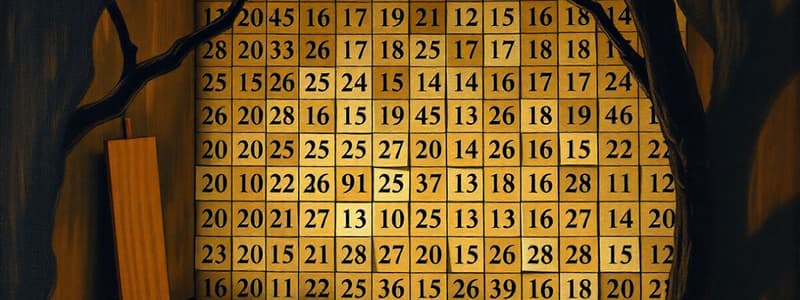Podcast
Questions and Answers
What does the pigeonhole principle state in this context?
What does the pigeonhole principle state in this context?
- All integers selected must be even to find multiples.
- Selecting more than 100 integers ensures multiple pairs exist.
- Choosing an odd number of integers ensures at least one pair of multiples.
- Among any 51 integers from 1 to 100, at least one integer is a multiple of another. (correct)
How many integers can be chosen from the set {1,2,3,...,100} to guarantee at least one pair of multiples?
How many integers can be chosen from the set {1,2,3,...,100} to guarantee at least one pair of multiples?
- 25
- 50
- 51 (correct)
- 100
Which of the following sets is most appropriate to illustrate the pigeonhole principle stated?
Which of the following sets is most appropriate to illustrate the pigeonhole principle stated?
- {2, 4, 6, 8, 10}
- {1, 3, 5, 7, 9, 11, 13}
- {1, 2, 3, 4, 5, 6, 7, 8, 9, 10}
- {1, 2, 4, 8, 16, 32, 64} (correct)
What is the maximum number of integers that can be selected without assuring a pair of multiples?
What is the maximum number of integers that can be selected without assuring a pair of multiples?
If 51 integers are chosen, how many unique bases can exist with respect to multiples?
If 51 integers are chosen, how many unique bases can exist with respect to multiples?
Flashcards are hidden until you start studying
Study Notes
Pigeonhole Principle
- States that if n items are put into m containers and if n > m, then at least one container must contain more than one item.
- Illustrates a principle of counting and is widely used in combinatorics and probability.
Application to Integers
- Consider the set of integers from 1 to 100.
- All integers can be expressed in the form of a product involving powers of 2 or 5, thus creating distinct "pigeonholes."
- Split the set into pairs: (1,2), (3,6), (4,8), ..., (32,64), ensuring that one number in each pair is a multiple of the other.
Selection of Integers
- If 51 integers are selected from the set of 100 integers, there are only 50 unique pairs (distinct multiples).
- By the Pigeonhole Principle, at least one of these pairs must contain both integers from the selected 51 numbers.
Conclusion
- Thus, among any 51 selected integers from 1 to 100, there will always exist at least two integers where one is a multiple of the other.
Studying That Suits You
Use AI to generate personalized quizzes and flashcards to suit your learning preferences.

